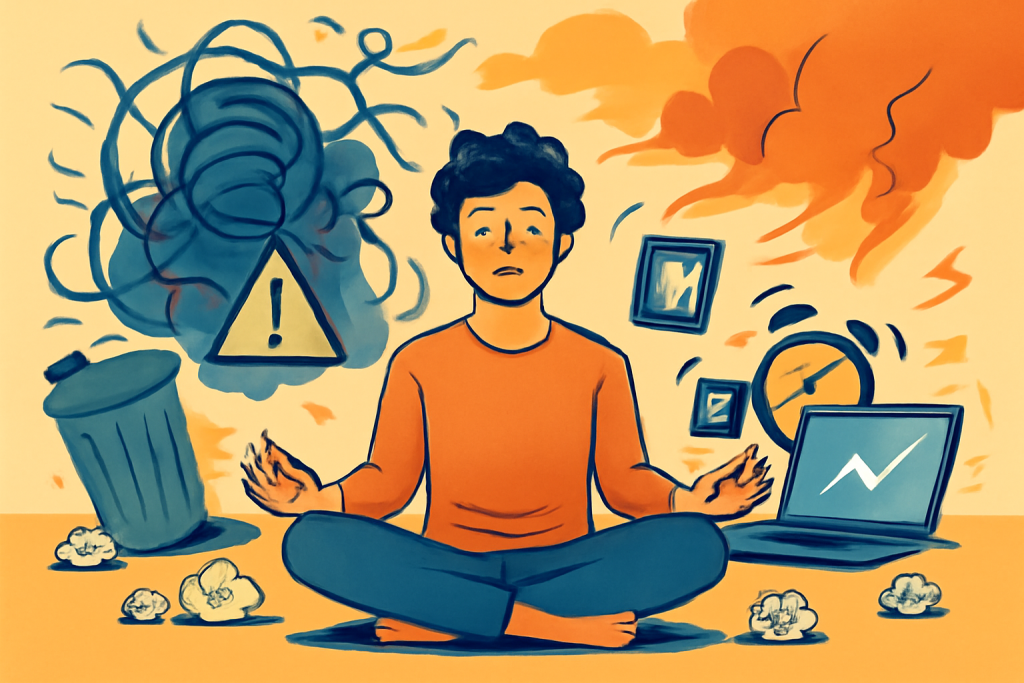Chaos is everywhere—from a relentless news cycle to work overload and personal life upheavals. Staying calm in chaotic environments isn’t just helpful; it’s essential for mental and physical well-being. The good news? You don’t need to be a Zen monk to master calm. These seven science-backed strategies are not just effective—they’re practical and accessible to everyone.

1. Practice Deep Breathing: The Calm Within Your Lungs
One of the most immediate and effective ways to calm your nervous system is through deep breathing. When you’re stressed, your sympathetic nervous system takes over, making your heart race and your breath shallow. This “fight or flight” response was helpful for our ancestors running from predators—not so much during a Monday morning meeting.
Deep breathing flips the switch to your parasympathetic nervous system, which helps you rest and digest. Techniques like box breathing (inhaling for four seconds, holding for four, exhaling for four, and pausing for four) are increasingly recommended in stress management programs (Mayo Clinic, 2021).
Practical Tip: Practice deep breathing first thing in the morning or before sleep for 5–10 minutes daily. Apps like Headspace and Calm offer guided breathing sessions.
2. Reframe Negative Thoughts: Cognitive Power at Work
Our thoughts shape our reality more than we realize. Cognitive Behavioral Therapy (CBT) has shown remarkable results in helping individuals reframe negative thinking patterns (Beck, 2020). Instead of spiraling into worst-case scenarios—“I’m going to lose my job”—CBT encourages you to challenge that thought and replace it with a balanced view—“I’m under pressure, but I’ve handled worse.”
The Science: Studies show CBT can reduce anxiety symptoms by up to 50% in just a few sessions (Hofmann et al., 2012). By consciously altering your inner dialogue, you create a sense of agency over your emotions.
Practical Tip: Keep a “thought journal.” When feeling overwhelmed, write down the negative thought, then challenge it with evidence and reframe it positively.
3. Embrace Mindfulness Practices: Be Here Now
Mindfulness means paying attention to the present moment without judgment. It may sound simple, but it’s one of the most powerful tools for reducing stress and improving focus. A Harvard study found that people spend 47% of their time thinking about something other than what they’re doing—and this mind-wandering makes them unhappy (Killingsworth and Gilbert, 2010).
Scientific Insight: Mindfulness practices like meditation, yoga, and even mindful walking significantly lower cortisol levels—the hormone responsible for stress (Tang, Hölzel & Posner, 2015).
Practical Tip: Set a timer for five minutes and sit silently. Focus only on your breath. Each time your mind wanders, gently bring it back. No judgment.
4. Build a Structured Routine: Find Comfort in Predictability
When everything around you feels out of control, establishing a routine is like setting an anchor in a stormy sea. Psychologists note that routines give a sense of normalcy and control. Something as simple as making your bed, planning meals, or scheduling exercise can be grounding.
Evidence-Based Benefits: Regular routines improve sleep quality, reduce anxiety, and increase productivity (Fiese et al., 2002). A clear daily structure gives your brain fewer decisions to make, preserving mental energy.
Practical Tip: Use a planner or digital calendar to schedule your day in advance. Prioritize sleep, meals, and self-care as non-negotiables.
5. Limit Information Overload: Curate Your Inputs
Being constantly bombarded with news alerts, social media updates, and emails is a fast track to feeling frazzled. This information overload activates the amygdala—your brain’s emotional response center—fueling anxiety.
According to the American Psychological Association, media exposure during high-stress events correlates with increased symptoms of stress and PTSD—even in people not directly affected by the events (APA, 2020).
Practical Tip: Designate specific “news-check” times in your day and turn off push notifications. Follow a 2-hour media-free zone before bed to improve sleep and calm.
6. Foster Social Connections: The Stress-Buffer Effect
Social support is one of the strongest buffers against stress. Studies have shown that people with strong social ties have lower blood pressure, fewer health issues, and longer life spans (Holt-Lunstad, Smith & Layton, 2010).
Even brief interactions—chatting with a neighbor or calling a friend—can help regulate your emotions. Isolation, on the other hand, is linked to depression and anxiety.
Practical Tip: Schedule regular “connection time,” whether it’s a video call with a friend or a walk with a family member. Don’t wait until you’re overwhelmed—stay connected proactively.
7. Focus on Controllables: Your Anchor in the Storm
In chaotic environments, it’s easy to feel powerless. But even in the worst situations, you have control over some things—your breathing, your reactions, your words, your sleep.
Focusing on these controllables brings structure and reduces anxiety. Viktor Frankl, a Holocaust survivor and psychiatrist, famously said, “When we are no longer able to change a situation, we are challenged to change ourselves.”
Evidence-Based Insight: A study in the Journal of Behavioral Therapy found that individuals who focused on controllable aspects of their lives reported higher resilience and lower stress levels (Bonanno et al., 2007).
Practical Tip: Make two lists—what you can control and what you can’t. Shift your attention and energy to the former.
Final Thoughts
Staying calm in chaos isn’t about ignoring reality or pretending everything’s fine. It’s about cultivating habits and mindsets that build emotional resilience. Implementing even a few of these science-backed strategies can make a significant difference in how you navigate life’s inevitable storms.
Remember, calm isn’t something that just “happens.” It’s a skill. Like any skill, it requires practice, patience, and intention.
References
- Mayo Clinic. (2021). Stress relief from laughter? It’s no joke. Available at: https://www.mayoclinic.org/healthy-lifestyle/stress-management/in-depth/stress-relief/art-20044456 (Accessed: 21 May 2025).
- Killingsworth, M. A., & Gilbert, D. T. (2010). ‘A Wandering Mind Is an Unhappy Mind’. Science, 330(6006), 932. DOI:10.1126/science.1192439
- Hofmann, S.G., Asnaani, A., Vonk, I.J.J., Sawyer, A.T. and Fang, A. (2012) ‘The Efficacy of Cognitive Behavioral Therapy: A Review of Meta-analyses’, Cognitive Therapy and Research, 36(5), pp. 427–440. DOI:10.1007/s10608-012-9476-1.
- American Psychological Association. (2020). Stress in America™ 2020: A National Mental Health Crisis. Available at: https://www.apa.org/news/press/releases/stress/2020/report-october (Accessed: 21 May 2025).
- Holt-Lunstad, J., Smith, T.B., & Layton, J.B. (2010). ‘Social relationships and mortality risk: a meta-analytic review’. PLOS Medicine, 7(7), e1000316. https://doi.org/10.1371/journal.pmed.1000316
- Bonanno, G.A., Papa, A., Lalande, K., Westphal, M. and Coifman, K. (2007) ‘The importance of being flexible: The ability to both enhance and suppress emotional expression predicts long-term adjustment’, Psychological Science, 15(7), pp. 482–487. DOI:10.1111/j.0956-7976.2004.00705.x.









